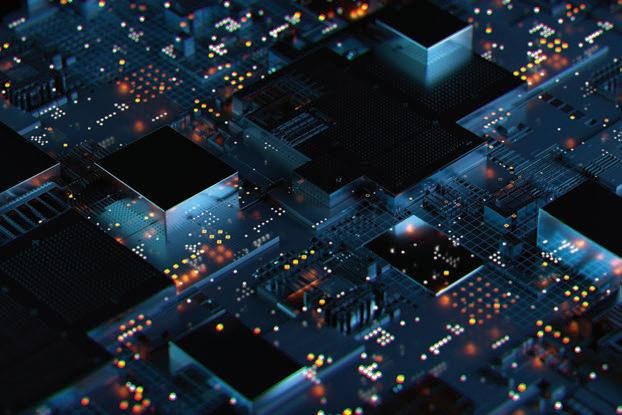
5 minute read
Assessing Cybersecurity
From understanding the most common threat vectors for industrial automation systems to evaluating threat detection capabilities, cybersecurity assessments are now as much a part of automation device feature functionality as processing speeds and connection ports.
With industrial automation devices increasingly being connected as part of Industrial Internet of Things (IIoT) and Industry 4.0 initiatives, a thorough understanding of cybersecurity threats and ways to guard against them have become basic requirements for the successful use of automation technology. The need for this knowledge extends from higher level automated systems like assembly workcells and robotics down to controllers and even sensors.
ATTACK VECTORS Before delving into protection methods, it’s important to first understand what you’re likely to be guarding your systems from. Aside from direct physical access, i.e., someone in-house exploiting your system directly, the two most common ways into an industrial network are: • From the top. In this set of scenarios, the attacker gains access first to the corporate enterprise network and then finds and infiltrates the industrial network. The good news for defenders is that this begins as a standard information technology (IT) realm cyberattack. The defense techniques are well known, if not always well practiced. The bad news is that, if the attackers are targeting the industrial network, they are likely to be skillful, stealthy, and persistent. • From the side. In this case, the attacker gains direct access to the industrial network by exploiting a provision for direct remote access. This could be a virtual private network or
RDP (remote desktop protocol) connection used by company engineers for remote troubleshooting, a remote access connection established for an equipment vendor, a compromised Internet of Things device, or even a back door previously installed by the attacker.
It is important to realize that these two ways are not mutually exclusive. The initial stages may rely on access from the top, but establishing the direct access from the side is likely to be an attacker priority.
Regardless of how the intruder accesses the operations technology (OT), the best defense is to be certain they have nowhere to go if they do get in. To instantiate this and provide the best protection possible, your system should have advanced authentication and encryption routines built in, making unauthorized access to any command and control capabilities impossible.
Regardless of how the intruder accesses the OT, the best defense is to be certain they have nowhere to go if they do get in. To instantiate this and provide the best protection possible, your system should have advanced authentication and encryption routines built in, making unauthorized access impossible.
EVALUATING DEVICE DETECTION TECHNOLOGIES One prominent feature oered by many cybersecurity providers is the ability to detect and analyze every device connected to your network, so as to quickly identify any possible rogue actors. But before assessing the merits of cybersecurity vendor A versus vendor B, first determine whether your organization is at a level of cyber defense maturity that makes the technology eective. Vendor demos make these tools look easy to use and deploy. However, the real power of the tool comes from the skills of the human analysts who set it up and use it.
Resilience requires the ability to detect, respond, and recover. To ensure system resiliency, you should be able to answer these questions: How does the technology contribute to the whole process? Who will use it? Do they have the skills and can they dedicate the time required? Do you have the required span ports or taps to connect it? Will it work well with other tools you already have in place?
If the above questions look intimidating, but you still want to learn something about the traffic on your network, consider experimenting with Grass Marlin (accessible on GitHub). This is a free mapping tool originally developed by the NSA for industrial networks. It is 100% passive. It can be used either for live capture or to analyze a pcap (packet capture) file of previously recorded network traffic.
Of course, any decision to purchase add-on cyber security tools should be evaluated in the context of whether your basic control system is itself secure. If it does not have advanced security built it to its electronics, the protection gained from any added tools will be severely limited. IT/OT COOPERATION One of the main reasons industrial control systems are being connected for IIoT and Industry 4.0 initiatives is so that the plant floor data can be more integrated into the executive decisionmaking process. And that requires close cooperation between front oce IT departments and plant floor OT experts.
To start o your IT/OT cooperation on the right foot, focus first on operational risks, not the network. For both attackers and operations, the network is the means, not an end in itself. Therefore, focus on the physical consequences of the cyber incident. What happens on the plant floor? How are you going to respond and recover? What are the operational requirements?
There are at least two ways to approach his discussion. One is a Cyber PHA (process hazard analysis). In industries with hazardous processes, this examines the risks identified in the normal PHA and considers whether they could be caused by a cyberattack. These are the operational nightmare scenarios. In extreme cases things can explode and people can get killed. The Cyber PHA is an important exercise because it can make it very clear what systems or devices need priority protection.
A second group of scenarios worth exploring is the consequences of a targeted ransomware attack. For the attackers, this is much easier than trying to blow something up. Ransomware is a commodity on the dark web. It also oers a potentially significant payday for the attackers. So far, reported industrial ransomware attacks have been surprisingly rare. These attacks are widely expected to become more common.






